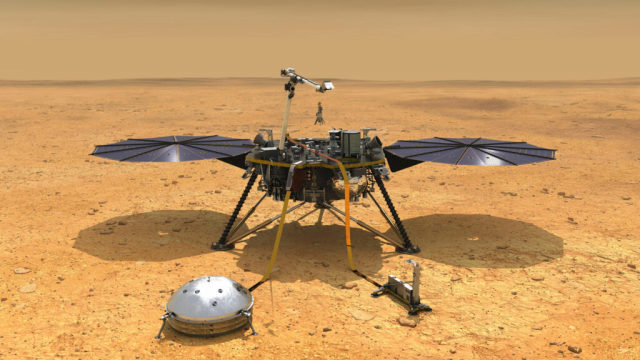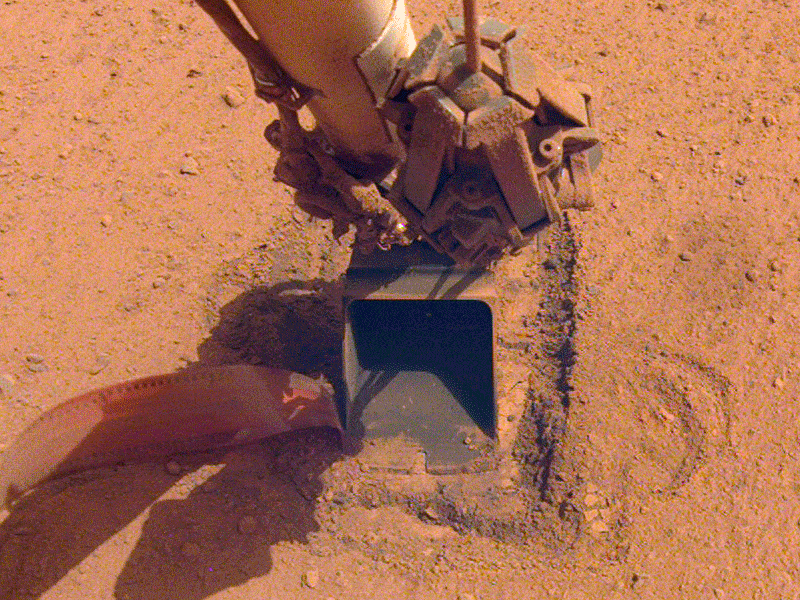The operators of the insight mission came to the conclusion that it is pointless to continue trying to drill the Martian surface. A drill with tools to measure the heat flow from the interior of the red planet could not dive deep enough due to lack of friction with the soil — it was too lumpy.
A few days ago, on the official website of the National Aeronautics and Space Administration of the United States (NASA) , a message appeared about the extension of the Mars insight mission (and the Jupiter Juno). This means that, despite exceeding the estimated period of operation, the instruments of the probe are in good condition, and therefore, scientists will continue to collect data from them. And conduct new experiments, of course.
In particular, it is planned to fill a small layer of soil with a plume that stretches from the landing platform to the seismometer. Thus, it is planned to reduce the influence of temperature fluctuations on the wires. The fact is that the oscillation sensor is incredibly sensitive — even a slight thermal expansion and reverse compression when cooling the loop with conductors causes interference. However, it was not without a fly in the ointment.
Bad news
The next news after the above is quite sad. The second most important instrument of the probe was a complete failure. In the more than two Earth years that insight has spent on Mars, the HP3 instrument suite has never begun its mission. The" Heat Flow and Physical Properties Package "was developed by the German Air and Space Research Center (DLR). It is a vibrating drill designed for immersion in the soil to a depth of at least three meters. After reaching this milestone, temperature sensors were supposed to measure the heat coming from the bowels of the planet.

An artistic representation of the insight probe on Mars. In the foreground, the mission's remote instruments are shown-on the left, the SEIS (Seismic Experiment for Interior Structure) seismometer under a protective dome, and on the right, the HP3 or "mole" with a supporting structure on top of it (later removed to help the drill penetrate deeper)
Image Source: NASA, JPL-Caltech
The nickname of this drill - "mole" (mole) — is not chosen by chance, but is based on the principle of its action. Like a live digger, HP3 relies on compacting the ground around the tunnel being dug. To move further, he needs to "push off" from the ground, which he has already pushed apart. More precisely, the walls of the vertical tunnel should be hard enough and rough enough that when the probe is hit, it does not bounce up, but falls deeper. The engineers ' calculations were based on existing data on the near-surface layer of Mars, which was obtained by previous missions. However, at the landing site of insight, it seems that the ground turned out to be somewhat different.
No matter how much the mission operators tried — the mole did not sink deeper than 2-3 centimeters below the surface. Even considering the length of the device itself (40 centimeters), it is still very far from the planned three meters. It is impossible to unearth everything around and see what is interfering with the drill. Apparently, he stumbled on a rock or a very dense layer of soil, and too loose surface soil does not create the necessary friction on the sides of the resulting tunnel. As a result, the tool just jumps in the hole.
Even pressing the HP3 end with the insight arm didn't help . More precisely, at first it seemed that this decision saved the situation. In the spring of 2020, the "mole" was literally shoved into the ground by the good old grandfather's method — the blow of a shovel. Okay, not a blow, of course, but the pressure was considerable, at least for a high-precision instrument, the impact force was decent. The blade on the manipulator rested on the upper end of HP3, and then applied additional clamping force simultaneously with the work of the "mole". Several tens of centimeters he so passed, but it turned out only to hide it under the surface and bury it from above.
No further progress was made. The last attempt was made by the operators on January 9, the device made five hundred strokes and did not move a millimeter. Officially, his work is complete. Since HP3 was created as a one-time device, it is not possible to remove it and move it to a new location with the manipulator. It remains to be satisfied only with what we managed to learn thanks to the failure.
It's not all bad
But do not despair: even a negative result is also a result, science works like this. Scientists have gained new ground for thinking about the Martian soil. And engineers will have to conduct many more simulations and practical experiments to develop a better tool for drilling. In addition, the insight team tested the probe in completely new roles for it.
For example, initially no one assumed that the manipulator could be used for such intensive earthworks and "rough" physical impact. Moreover, it was not designed for this in principle. However, I managed it. Based on this experience, operators now plan to improve the performance of the second key insight tool. As already mentioned, the manipulator will become a full-fledged excavator and with its help, the wires of the seismometer will be buried.
In addition, in February, a new mission will arrive on Mars — the Perseverance rover. There is a possibility that the incredibly sensitive insight seismometer will "hear" its landing. If it turns out, then such an event will be the first in history. Moreover, there can be several sources of vibrations at once.
- First, the most obvious — the fall of 77-kilogram balancers (CMBD), which the Rover will drop at an altitude of about 1,500 kilometers. They are needed to align the center of mass during the flight and before entering the atmosphere, you need to get rid of them. They will meet with the surface of the planet at a speed of about 14 thousand kilometers per hour: such an impact should be powerful enough that the seismic waves from it are caught by a sensitive sensor at a distance of 3.5 thousand kilometers.
- Second, the least likely is a shock wave from the supersonic motion of a rover entering the atmosphere. Yes, the gas envelope of Mars is very thin, but there is a chance, even if very small. The shock wave will reach the surface and generate seismic vibrations.
But the very moment of landing to catch the seismometer will only work if it does not go according to plan and ends with the failure of parachutes. But this is an extremely undesirable outcome of events.

